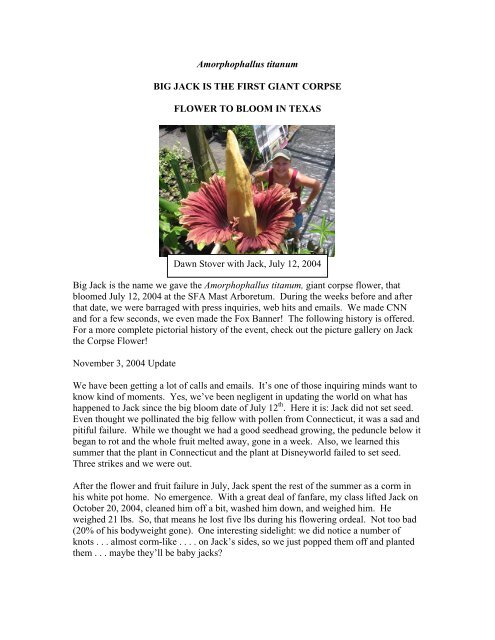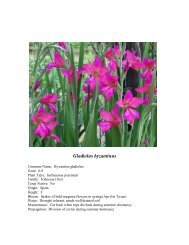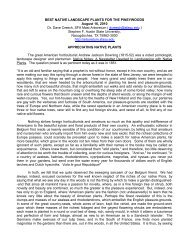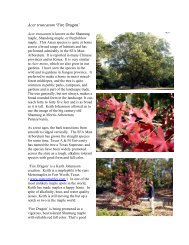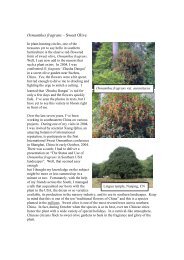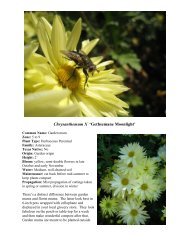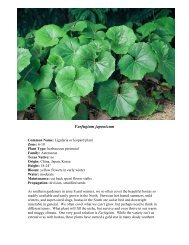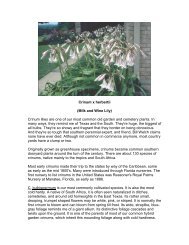BIG JACK IS THE FIRST GIANT CORPSE - SFA Gardens
BIG JACK IS THE FIRST GIANT CORPSE - SFA Gardens
BIG JACK IS THE FIRST GIANT CORPSE - SFA Gardens
You also want an ePaper? Increase the reach of your titles
YUMPU automatically turns print PDFs into web optimized ePapers that Google loves.
Amorphophallus titanum<br />
<strong>BIG</strong> <strong>JACK</strong> <strong>IS</strong> <strong>THE</strong> <strong>FIRST</strong> <strong>GIANT</strong> <strong>CORPSE</strong><br />
FLOWER TO BLOOM IN TEXAS<br />
Dawn Stover with Jack, July 12, 2004<br />
Big Jack is the name we gave the Amorphophallus titanum, giant corpse flower, that<br />
bloomed July 12, 2004 at the <strong>SFA</strong> Mast Arboretum. During the weeks before and after<br />
that date, we were barraged with press inquiries, web hits and emails. We made CNN<br />
and for a few seconds, we even made the Fox Banner! The following history is offered.<br />
For a more complete pictorial history of the event, check out the picture gallery on Jack<br />
the Corpse Flower!<br />
November 3, 2004 Update<br />
We have been getting a lot of calls and emails. It’s one of those inquiring minds want to<br />
know kind of moments. Yes, we’ve been negligent in updating the world on what has<br />
happened to Jack since the big bloom date of July 12 th . Here it is: Jack did not set seed.<br />
Even thought we pollinated the big fellow with pollen from Connecticut, it was a sad and<br />
pitiful failure. While we thought we had a good seedhead growing, the peduncle below it<br />
began to rot and the whole fruit melted away, gone in a week. Also, we learned this<br />
summer that the plant in Connecticut and the plant at Disneyworld failed to set seed.<br />
Three strikes and we were out.<br />
After the flower and fruit failure in July, Jack spent the rest of the summer as a corm in<br />
his white pot home. No emergence. With a great deal of fanfare, my class lifted Jack on<br />
October 20, 2004, cleaned him off a bit, washed him down, and weighed him. He<br />
weighed 21 lbs. So, that means he lost five lbs during his flowering ordeal. Not too bad<br />
(20% of his bodyweight gone). One interesting sidelight: we did notice a number of<br />
knots . . . almost corm-like . . . . on Jack’s sides, so we just popped them off and planted<br />
them . . . maybe they’ll be baby jacks?
July 14, 2004 Update<br />
There’s no humility here! Jack finished up at 61” tall and started opening on Monday<br />
July 12, 2004 around 1:00 PM. When he unfolded, there was no doubt about it; he was<br />
incredible, a truly amazing and mysterious botanical masterpiece. At 2 PM we still<br />
weren’t positive this was the real thing – heck, how many folks have had experience with<br />
this? – so we put out a web alert that said we “think” he’s opening. At 3 PM, we knew<br />
we had an event and the announcement went out. The bloom opened to its finest that<br />
night around eight and Jack began cranking out a stench that withered the crowd. The<br />
delightful smell of spoiled meat was powerful enough to<br />
be detected over 100 yards away. Flies made their way<br />
to our shadehouse. Jack was reeking right in the middle<br />
of a crowd of admirers.<br />
Around eight that night we cut a small rectangular<br />
window in the side of the spathe and we brushed on, blew<br />
on and chanted on pollen mixed in a little powdered milk.<br />
We even put on a little Barry White music for good luck.<br />
The pollen had arrived from Connecticut only a few<br />
hours before, a gift from the University of Connecticut<br />
via Clinton Morse. We sealed up the window with duct<br />
tape, kept up a little Jungle Blues music, said a few<br />
prayers and congratulated ourselves that Jack was<br />
pollinated.
On Tuesday morning Jack was still in fine shape but the spathe had moved upward a bit,<br />
as if he wanted to close. On Wednesday, pollen was extruded from the anthers and<br />
looked like tiny strands of grated cheese. That was carefully collected with a spatula,<br />
quickly placed in a bag with powdered milk to aid in the drying and shipped to James<br />
Thompson of Disney World where another Titan Arum was about do its thing. So the<br />
pollen chain continues! From what I understand, the University of Connecticut plant<br />
failed to set fruit and the plant withered away . . . so we have two chances left here to get<br />
viable seed: <strong>SFA</strong>’s Jack and Disney World’s Claire.<br />
At this writing, Jack is nearing the end of his life. One of his spathe edges flopped over<br />
yesterday. On Thursday night July 15th, the spadix flopped over around 9 PM. That<br />
meant that Jack’s spadix had been erect for about 77 hours from the first signs of opening.<br />
Evidently the spadix collapse normally takes place after 48 hours, but Jack fooled all of<br />
us. On Friday July 16th, Dr. Shiyou Li, Director of <strong>SFA</strong>’s Center for Medicinal Plant<br />
Research, collected a section of the spadix for analysis. Perhaps Jack’s contribution will<br />
continue as a cure for cancer or a disease.<br />
We are soooooooo proud of Jack. He’s done well. We know he wasn’t the biggest corm<br />
ever. Let’s face it: at 26 lbs. he was a small corm in the World of Amorphophallus corms.<br />
Everyone here can attest that he hasn’t had a plush lifestyle the last four years. But he’s a<br />
Texan. He’s an <strong>SFA</strong> Lumberjack. He loved the attention, the kids, the crowds and he’ll<br />
always be a memory to this wonderful garden in the Pineywoods of East Texas.<br />
Stay tuned to this website for the announcement of a CD of high resolution images and to<br />
keep posted on the success of our pollination. We need a nap.<br />
Who is Big Jack?<br />
Big Jack is Amorphophallus titanum – the infamous Titan Arum or Giant Corpse Flower<br />
and it is found exclusively in the equatorial rainforests of Sumatra, Indonesia. The plant<br />
is said to grow in openings in the rainforest on limestone hills. The plant was discovered<br />
by Italian botanist Odoardo Beccari in 1878. The plant is endangered in the wild and<br />
very few exist in cultivation.<br />
How rare is this blooming event?<br />
After its discovery in 1878, seeds from the wild resulted in the first blooming of this<br />
species in cultivation at Kew in England in 1889. The first recorded bloom in the U.S.<br />
was at the New York Botanical Garden in 1937. There have been only about two dozen<br />
recorded flowering events in the USA since then. A flowering event is often turned into<br />
a giant extravaganza for those few botanical gardens and arboreta that have been blessed
with a plant that survives and actually flowers successfully. This Texas plant proudly<br />
joins the list.<br />
How does this plant do what it does?<br />
The plant grows from a large corm which reaches weights up to 200 lbs. in the wild.<br />
Typically, the corms are smaller in cultivation but often top 75 lbs. or more. For most of<br />
their life, corms produce solitary, highly dissected leaves over 12’ high and 10’ across.<br />
Leaves persist for about a year and senesce. The plant then enters a dormant phase of<br />
several months. A replacement leaf emerges and the plant moves to growing a new root<br />
system and adding to the size of the corm. After a year or so, the process is repeated.<br />
Infrequently, instead of a replacement leaf, the corm will generate the blessed event: a<br />
flower. In that season, the leaf will emerge only after the flower has collapsed. The<br />
entire life cycle of leaf growth, flowering, and dormant periods is botanically strange,<br />
considering that these plants are found only warm equatorial jungle habitats. Equally<br />
curious, in the wild, the stages are evidently quite randomly spaced, with some plants in<br />
various stages of growth at any given time. The evolutionary significance of this is a<br />
matter of great debate. The plant is known to live forty years or more and can flower<br />
several times in its life cycle.<br />
What’s the big deal about this flower?<br />
First, let’s be correct. Titan Arum had the title of the largest “flower in the world” but<br />
technically, the “flower” is really an “inflorescence", or a cluster of flowers. The spadix<br />
can reach over 6 feet tall (the tallest ever recorded was over 10 feet), and when fully open<br />
the spathe can reach about 3 feet across. Thousands of true flowers are hidden inside at<br />
the base of the spadix (the fleshy central column). The large frilly-edged leafy structure<br />
enclosing the spadix is called the spathe. Male and female flowers are separate and in a<br />
ring around the base of the plant, with the female flowers below and receptive first, the<br />
male flowers above and releasing pollen the next day. This means that the plant must be<br />
cross pollinated. A plant will not produce seed unless pollinated from another plant<br />
because of the timing of stigma receptivity and pollen release. We call this dichogamy.<br />
How bad is the odor?<br />
Very few people have been blessed enough to catch the corpse flower at its most<br />
powerful fragrance. Most bizarre to the general public is that when the flower is fully<br />
open, it emits the nauseating fragrance of rotten meat (hence its Indonesian common<br />
name ‘Bunga Bangkai’). The odor begins on opening of the inflorescence and lasts for<br />
about 8 hours. The flower typically stays open 18 hours to two days. The stench,<br />
strongest at night, is there to attract pollinators, thought to be carrion beetles and sweat<br />
bees in the wild. The odor is reported to be emitted in waves as a gas and as a colleague<br />
of mine at the University of Connecticut recently told me, “a good whiff at the wrong<br />
time caused great pain and made my sinuses hurt for several days.” This sounds like a<br />
sure fire way to create a lifelong Amorphophallus Avoidance Anomaly Syndrome.<br />
Rule:don’t stick your head into an open flower in the first eight hours.
The flower is actually hot?<br />
Yes, isn’t that amazing? Along with the odor, while the flower is first open, the spadix<br />
warms itself with metabolic heat, in what is thought to be an adaptation to volatilize and<br />
disperse its horrible carrion smell and insect-attracting chemistry. Temperatures in the<br />
depths of this flower are said to reach 5 to 20 degrees above ambient.<br />
Where did <strong>SFA</strong>’s Big Jack come from?<br />
Jack originally came from Florida on June 1, 2000. The <strong>SFA</strong> plant was given to me as a<br />
dormant fist-sized corm by Russell Adams of Gainesville Tree Farm in Florida. Russ is<br />
an avid horticulturist focused on growing a wide range of very rare palms, desert plants<br />
and Aroids. During a visit to his nursery after a speaking engagement, I had the joy of<br />
touring his collection and talking the wonderful world of plants. At one point he showed<br />
me a dormant Amorphophallus titanum corm. There’s no doubt he saw my green-withenvy-I-want-that-plant<br />
look in my eye. He said no, he couldn’t part with it. I told him I<br />
would crawl two miles in the mud to get that plant for the <strong>SFA</strong> Mast Arboretum. He said<br />
no again so I dropped it. We continued to tour and talk plants and just as I was about to<br />
drive away he handed me the corm with a few instructions on its care, and Jack was on<br />
his way to Texas.<br />
Jack quickly made his home in a pot and was grown along with thousands of other plants<br />
and by some miracle the plant was always drug into the greenhouse when the cool<br />
weather arrived in the fall and was drug back into the shadehouse when spring was fully<br />
in place. There was a shifting up in 2002 to a 15 gallon pot. The plant made some waves<br />
in 2003 with an 8’ leaf and thick trunk. Jack was moved into the greenhouse in the fall<br />
2003 and kept a healthy leaf all the way into February 2004 before crashing back to the<br />
ground. In March 2004, it was decided that Jack had done so well in 2003, he deserved a<br />
big new pot. Jack was repotted by students in a lab and at that time the corm was healthy<br />
and weighed in at a respectable 26 lbs and 2 ozs. We didn’t know it then, but Jack was<br />
thinking of flowering. Jack emerged in mid-June 2004 and while we thought we had a<br />
leaf, it wasn’t long before we realized Jack was producing a flower.<br />
You pollinated Jack?<br />
Yes! Pollen was mailed from a University of Connecticut plant that just finished<br />
flowering. The pollen should arrive July 12, 2004. Clinton Morse and Matthew Opel<br />
have just endured an exhausting three week event that ended right before our Jack opened.<br />
However, Clinton tells me that the plant performed a bit less than expected and only<br />
stayed open 18 hours. The flower there was pollinated by frozen pollen from a plant at<br />
the Fullerton Arboretum that flowered several years ago. This means that Jack – with the<br />
University of Connecticut pollen – will be working with “fresh pollen”. The pollen was<br />
delivered in a styrofoam container and was still cool when it arrived. Jack was pollinated<br />
on Monday night about 8 PM. The tiny amount of pollen was carefully dusted on to the<br />
stigmas through a window we cut in the lower section of the spathe. This was, of course,
a very stinky job because Jack was effusing his charm quite vigorously at that time. Bot<br />
flies and other flies had found this carcass and we’re lighting on the spadix. Hopefully,<br />
we will have good fertilization and a seed crop and baby Jacks. On Wednesday, we<br />
collected Jack’s pollen and that was mailed on to Jim Thompson at Disney World’s<br />
Animal Kingdom conservatory; a plant there is about to bloom! The pollen chain will<br />
continue until there’s one of the plants in every household in America! Stay tuned<br />
How do we take care of Jack?<br />
Essentially Jack has had to live his life on much the same regimen as all the other plants<br />
that surround him. We have a good organic substrate for him to live in. We fertilize him<br />
modestly and try to keep him moist. Even during the dormant period, the corm should be<br />
kept slightly moist.


